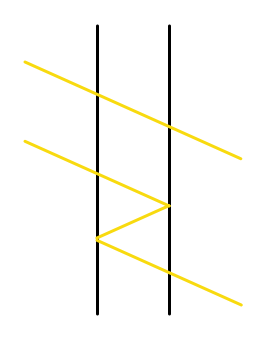Double Pane Windows

My double pane windows will each transmit 70%, reflect 20% and then absorb the remaining 10% of light that falls on it. What is the total percentage (in %) of light that passes through to the other side?
The answer is 51.04.
This section requires Javascript.
You are seeing this because something didn't load right. We suggest you, (a) try
refreshing the page, (b) enabling javascript if it is disabled on your browser and,
finally, (c)
loading the
non-javascript version of this page
. We're sorry about the hassle.
First we think of ways light could pass through to the other side.
In the diagram, two ways are given. These are T T , that is - light being transmitted by the first pane, and then being transmitted by the second pane, as well as T R R T , that is - light being transmitted by the first pane, reflected by the second, reflected back by the first and finally transmitted by the first.
Now we can consider what the general case is for light passing through. It must be transmitted once and only once by the both the panes, as this is the only way it can reach the other side, and the cases where it transmitted more than once for either pane can be analysed as being undesirable.
In addition, if it is reflected by the second pane it will be travelling backwards, so will need to be reflected back by the first pane. This can be repeated and generalises as follows - the light will pass through if it is transmitted twice and reflected an even number of times .
The percentage of light that passes through is equal to sum of the percentage of light passing through in different each possible way.
We therefore the gain the following infinite series, summing the percentage probability of each case T T , T T R R , T T R R R R , . . . , these being all the possible cases with two transmissions and an even number of reflections.
S = 0 . 7 2 + 0 . 7 2 0 . 2 2 + 0 . 7 2 0 . 2 2 0 . 2 2 + . . .
We can multiply by 0 . 2 2 to gain self similarity
0 . 2 2 S = 0 . 7 2 0 . 2 2 + 0 . 7 2 0 . 2 2 0 . 2 2 + 0 . 7 2 0 . 2 2 0 . 2 2 0 . 2 2 + . . .
Therefore
S − 0 . 2 2 S = 0 . 7 2
and
S − 0 . 0 4 S = 0 . 4 9
which is
0 . 9 6 S = 0 . 4 9
so
S = 0 . 4 9 / 0 . 9 6 = 4 9 / 9 6
and calculating this fraction as a percentage, and to two decimal places (which could be specified in the question) gives 5 1 . 0 4